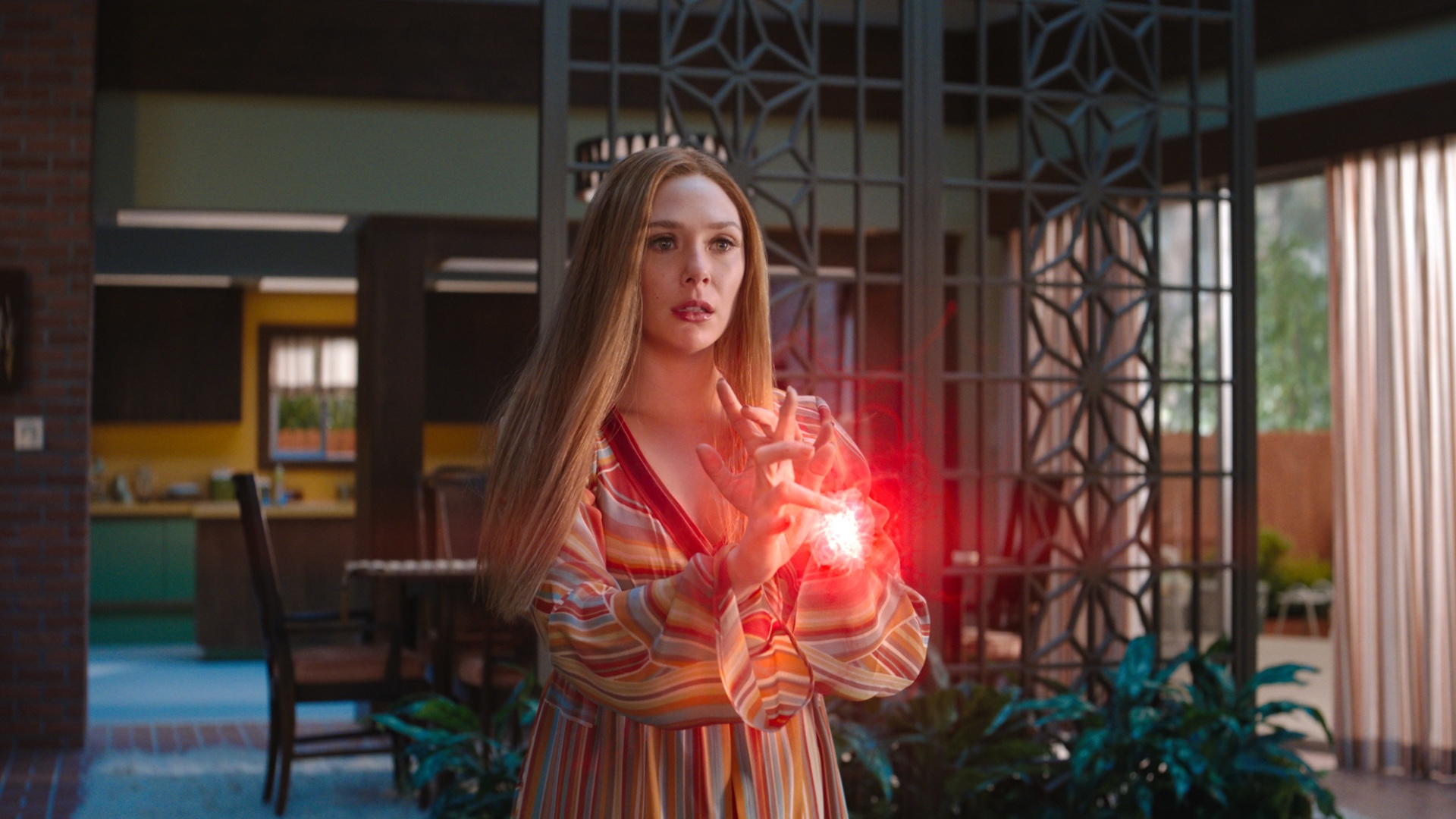This article contains spoilers for WandaVision episode 4.
We’re officially four episodes into WandaVision, and the situation in Westview is starting to heat up. But with more than half of the remaining season left yet to air (the first season consists of a planned nine episodes), there’s still so much more we don’t know.
Although the first three episodes were firmly ensconced in the sitcom-esque small-town reality that Wanda Maximoff (Elizabeth Olsen) and Vision (Paul Bettany) find themselves in, with only the occasional blip to indicate that something strange is going on, episode 4, titled “We Interrupt This Program,” finally pans out to reveal the true circumstances of the situation. Not only is the town of Westview, New Jersey trapped within some type of cosmic energy field (the likes of which resemble the swirls and patterns of an old TV screen), but it appears that the person ultimately responsible for keeping everyone contained within this fantasy world… is Wanda herself.
The possibility that Wanda was the force behind the mystery of Westview is a theory that has been circulated within the show’s viewer base since the first episode aired — and, in particularly delightful form, all those fan theories were something the series itself referenced as FBI Agent Jimmy Woo (Randall Park) and Dr. Darcy Lewis (Kat Dennings), working in tandem with the organization known as SWORD, posited various theories about what was going on in the town. Was the universe responsible for casting two Avengers in a sitcom, or was something more sinister at stake? How was it even possible that Vision was popping up on screen alive and well, when by all accounts he had definitely died during the events of Avengers: Infinity War? And why sitcoms, of all things?
Scenes from the past three episodes, in which Woo and Lewis attempt to reach out to Wanda through the energy barrier and fail, are given more context in this episode as well. Everything leading up to this has been about SWORD trying to figure out how to get into Westview and, hopefully, rescue the Avengers from whatever force is trapping them inside — but the truth proves to be much more understandable than that.
“We Interrupt This Program” is the episode where we finally learn where this series takes place in the overall timeline of the MCU. As it turns out, “Geraldine” is actually Monica Rambeau (Teyonah Parris), daughter of pilot and Captain Marvel’s close friend Maria Rambeau. When Monica returns to reality following the Hulk’s reversal of Thanos’ snap, she finds a world that is five years gone from when she left it, and her mother having long since passed away from the cancer that was supposedly in remission.
Read more
Three weeks later, though, Monica is back at SWORD and ready to take on her next assignment, which is how she ends up in Westview — and accidentally falling into a strange reality as she tries to investigate the mystery firsthand. At first, “Geraldine” easily befriends Wanda and Vision, but in the aftermath of Wanda giving birth to twins Tommy and Billy in episode 3, “Now in Color,” Monica inadvertently reveals that she knows about Pietro, Wanda’s own twin who was murdered by Ultron. In an instant, Wanda’s entire demeanor towards her new friend changes, and we later see her using her own magic to eject Monica from the town.
“It’s Wanda. It’s all Wanda,” Monica says upon her return.
Since episode 4 aired, speculation has understandably swirled about Wanda’s state of mind — whether she had gone evil, become the “true villain” of the series, or whether she was being directed to create this cosmic field by some greater power — but the reality likely lies much closer to what’s clearly spelled out for us in that ending scene than anything we could theorize.
When Vision returns to the house, Wanda initially perceives him in the form he took when he died in Infinity War, after the Mind Stone was forcibly ripped from his head in spite of Wanda’s own attempts to destroy it before Thanos could secure it for himself. Clearly rattled by the sight, she glances away, and when she looks back again, he’s alive and well again. Or is he? Vision tries to tell Wanda that they can leave Westview and go somewhere else, and with tears in her eyes, she says that it isn’t possible before they sit down on the couch together with their newborn children.
As the episode itself reveals in a scene between Monica and SWORD acting director Tyler Hayward (Josh Stamberg), it’s been three weeks or so since the conclusion of Endgame. That means Wanda has only had three weeks to fully grieve Vision’s passing — since she was one of those who got snapped away at the end of Infinity War, only to be returned for the final battle. Three weeks next to those left behind who had years to process their own losses.
One could argue that Wanda hasn’t even had sufficient opportunity to mourn the death of her twin brother either, since the schedule of an Avenger seems wrapped up in larger-than-life clashes and world-ending stakes with very few opportunities for quiet in between. As of now, she’s lost the two most important people in her life, the two individuals she was closest to, and as the rest of the world moves on, it’s never been more clear that Wanda hasn’t.
However, calling Wanda the villain of the show overlooks the manifest ways in which grief takes shape and erases the complexities of an arc that has slowly begun to unfold over the course of the first half of this season. She may be an antagonizing force, an obstacle for other characters to contend with, but reducing her to pure villainy doesn’t take into account what she’s been through leading up to this series.
Read more
At her core, she’s still a hero — she’s just also a woman in mourning, and right now, the way she is choosing to cope with her grief is to compartmentalize it, to bottle it up somewhere where it can’t get to her and overwhelm her beyond reason. Of course, there’s the clear evidence that she is using her powers to manipulate others, controlling normal citizens into acting out the intricacies of her fantasy sitcom world, and that is something that should have definitive consequences for her later on.
But the true brilliance of Wanda’s narrative in this show, ultimately, is that it can’t be fit into such a simple dichotomy as good vs. evil, and referring to her as a villain is a simplistic description for a character that has long-since deserved more time spent on her than she’s been afforded in the past. It would be convenient to position Monica as the hero tasked with taking down the evil Scarlet Witch, for example, although how much more poignant would it be if this series ended up revolving more around two women who connect through their shared grief, if Monica and Wanda bond in the losses they’ve suffered and ultimately come out stronger as a united force?
It would do both of these characters justice and, in the process, discard so many lazy storytelling shortcuts that would have pitted them against each other instead. There’s still over half a season left to air, and this likely won’t be the last time these two women share the screen in WandaVision, but in the meantime, until we see what unfolds, we should reject the circulating idea that Wanda is the villain of her own story — because she is, and always has been, much more complicated than that. This just happens to be the first time we’re really getting to see it.
New episodes of WandaVision premiere every Friday on Disney+.




